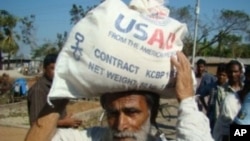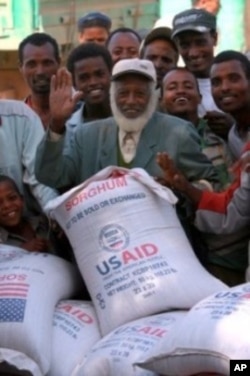New recommendations call for significant changes in the nutritional content of foods the United States delivers to the world's hungry.
The United States is the world's largest supplier of food aid, reaching 55 million people in 46 countries last year, according to the U.S. Agency for International Development (USAID).
That assistance has saved millions of lives over the years.
But Tufts University nutrition expert Patrick Webb says, "There was a bit of an impression that as long as you delivered food, that was enough. And really, what we have been arguing and demonstrating is that, no, just any old food isn't enough."
Webb says that's especially true for young children, who have greater nutritional needs in the first thousand days of life. In the new report commissioned by USAID and released Tuesday in Washington, Webb and his colleagues note that malnutrition in the period from the womb to age two can cause irreparable damage to a child's growth and brain development. That in turn affects a child's ability to learn and ultimately lowers national productivity.
The report recommends more nutritious foods for children under two and pregnant women.
USAID Administrator Rajiv Shah says the report may lead to significant changes. "We'll look specifically into the recommendations into how to get more animal protein into foods so kids don't just get calories, but get the nutrition they need for brain development and human growth."
The report also recommends improving the vitamin and mineral content of grains and oils. Those are relatively easy fixes that may reach beneficiaries this year. But adding animal protein to food targeted for young children is more difficult to accomplish.
"Unfortunately, there are manufacturing challenges that come to bear, looking at things like shelf life as well as cost," says Stephen Moody, USAID food technology expert.
But Susan Shepherd with the humanitarian group Doctors without Borders says the report does not go far enough.
"It's not at all clear to me that this report is making a strong stand in terms of improving the quality of foods they're trying to give to children," she says.
Shepherd adds that while the report acknowledges the value of nutrient-packed ready-to-eat foods for treating malnutrition, it continues to rely on cheaper fortified grain and soybean blends that do not provide enough nutrition for young children.
And she says it does not provide aid workers with enough guidance on using ready-to-eat foods.
"If I read this report as somebody in the field, it's all over the map," she says. "I don't know what I should be using when. And as long as they keep focusing on how much it costs, how much it costs, how much it costs, then these kids are never going to get what they need."
But USAID officials say they are already seeing benefits in programs that are currently following the report's recommendations. They say within a year other programs will start to see changes that will fight malnutrition more effectively among some of the world's most vulnerable people.














